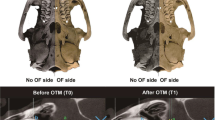Abstract
Introduction
To quantify the rate of tooth movement in two corticotomy protocols in an experimental model in rats through macroscopic and radiographic analysis.
Methods
The animals were divided into three groups: orthodontic movement (CO), orthodontic movement plus corticotomy surgery (G2), and orthodontic movement and corticotomy surgery with decorticalization (G3).The euthanasia occurred in 7 and 14 days. The data were statistically analyzed (p < 0.05).
Results
The CO presented lower distance between the mesial surface of the first molar and the distal surface of the third molar when compared to the G2 (6.96 ± 0.24, p = 0.009) and G3 (6.93 ± 0.18, p = 0.016) in the macroscopic analysis. In the 7 days, there was no statistically significant radiographic difference between the three groups: CO(0.94 ± 0.21 mm2), G2(1.05 ± 0,27 mm2), and G3(1.08 ± 0.27 mm2).There was a statistically significant difference between CO (0.87 ± 0.12 mm2), G2 (1.00 ± 0.12 mm2), and G3 (1.11 ± 0.14 mm2) at 14 days. There was a statistically significant linear difference between the groups in all periods.
Conclusion
Tooth movement and the region of interest were influenced by corticotomy, regardless of the surgical technique in the 14 days.






Similar content being viewed by others
References
Murphy CA, Chandhoke T, Kalajzic Z, Flynn R, Utreja A, Wadhwa S, Nanda R, Uribe F (2014) Effect of corticision and different force magnitudes on orthodontic tooth movement in a rat model. Am J Orthod Dentofac Orthop 146(1):55–66. https://doi.org/10.1016/j.ajodo.2014.03.024
Dibart S, Yee C, Surmenian J, Sebaoun JD, Baloul S, Goguet-Surmenian E, Kantarci A (2014) Tissue response during piezocision-assisted tooth movement: a histological study in rats. Eur J Orthod 36(4):457–464. https://doi.org/10.1093/ejo/cjt079
Charavet C, Lecloux G, Bruwier A, Rompen E, Maes N, Limme M, Lambert F (2016) Localized piezoelectric alveolar decortication for orthodontic treatment in adults: a randomized controlled trial. J Dent Res 95(9):1003–1009
Wilcko W, Wilcko T, Bouquot E, Ferguson D (2001) Rapid orthodontics with alveolar reshaping: two case reports of decrowding. Int J Periodontics Restorative Dent 21:9–19
Sukurica Y, Karaman A, Gurel B, Dolanmaz D (2007) Rapid canine distalization through segmental alveolar distraction osteogenesis. Angle Orthod. 77:226–236
Abbas N, Sabet NE, Hassan T (2016) Evaluation of corticotomy-facilitated orthodontics and piezocision in rapid canine retraction. Am J Orthod Dentofac Orthop 149:473–480
Richter AE, Arruda AO, Peters MC, Sohn W (2011) Incidence of caries lesions among patients treated with comprehensive orthodontics. Am J Orthod Dentofacial Orthop 139(5):657–664. https://doi.org/10.1016/j.ajodo.2009.06.037
Geiger AM (1980) Mucogingival problems and the movement of mandibular incisors: a clinical review. Am J Orthod 78(5):511–527
Alexander SA (1991) Effects of orthodontic attachments on the gingival health of permanent second molars. Am J Orthod Dentofacial Orthop 100(4):337–340. https://doi.org/10.1016/0889-5406(91)70071-4
Weltman B, Vig KW, Fields HW, Shanker S, Kaizar EE (2010) Root resorption associated with orthodontic tooth movement: a systematic review. Am J Orthod Dentofac Orthop 137(4):462–476. https://doi.org/10.1016/j.ajodo.2009.06.021
Grünheid T, Morbach BA, Zentner A (2007) Pulpal cellular reactions to experimental tooth movement in rats. Oral Surg Med Oral Pathol Oral Radiol Endod 104:434–441
Baloul SS, Gerstenfeld LC, Morgan EF, Carvalho RS, Van Dyke TE, Kantarci A (2011) Mechanism of action and morphologic changes in the alveolar bone in response to selective alveolar decortication–facilitated tooth movement. Am J Orthod Dentofacial Orthop 139(4 Suppl):S83–S101. https://doi.org/10.1016/j.ajodo.2010.09.026
Ferreira CL, Rocha VC, Ursi W, De Marco AC, Santamaria M, Santamaria MP, Jardini MAN (2018) Periodontal response to orthodontic tooth movement in diabetes-induced rats with or without periodontal disease. J Periodontol 89(3):341–350. https://doi.org/10.1002/JPER.17-0190
Hong RK, Yamane A, Kuwahara Y, Chiba M (1992) Theeffect of orthodontic retention on the mechanical properties of the periodontal ligament in the rat maxillary first molar. J Dent Res 71:1350–1354
Dibart S, Sebaoun JD, Surmenian J (2009) Piezocision: a minimally invasive, periodontally accelerated orthodontic tooth movement procedure. Compend Contin Educ Dent 30:342–344 346, 348–3450
Sanjideh PA, Rossouw PE, Campbell PM, Opperman LA, Buschang PH (2010) Tooth movements in foxhounds after one or two alveolar corticotomies. Eur J Orthod 32:106–113
Librizzi Z, Kalajzic Z, Camacho D, Yadav S, Nanda R, Uribe F (2017) Comparison of the effects of three surgical techniques on the rate of orthodontic tooth movement in a rat model. Angle Orthod 87:717–724
Peron AP, Johann AC, Papalexiou V, Tanaka OM, Guariza-Filho O, Ignácio SA, Camargo ES (2017) Tissue responses resulting from tooth movement surgically assisted by corticotomy and corticision in rats. Angle Orthod. 87:118–124
Mostafa YA, Mohamed Salah Fayed M, Mehanni S, ElBokle NN, Heider AM (2009) Comparison of corticotomy-facilitated vs standard tooth-movement techniques in dogs with miniscrews as anchorage units. Am J Orthod Dentofac Orthop 136(4):570–577. https://doi.org/10.1016/j.ajodo.2007.10.052
Wilcko MT, Wilcko MW, Pulver JJ, Bissada NF, Bouquot JE (2009) Accelerated osteogenic orthodontics technique: a 1-stage surgically facilitated rapid orthodontic technique with alveolar augmentation. J Oral Maxillofac Surg 67(10):2149–2159. https://doi.org/10.1016/j.joms.2009.04.095
Verna C, Dalstra M, Melsen B (2000) The rate and type of orthodontic tooth movement is influenced by bone turnover in a rat model. Eur J Orthod 22:343–352
Cho KW, Cho SW, Oh CO, Ryu YK, Ohshima H, Jung HS (2007) The effect of cortical activation on orthodontic tooth movement. Oral Dis 13:314–319
Cano J, Campo J, Bonilla E, Colmenero C (2012) Corticotomy-assisted orthodontics. J Clin Exp Dent 4:e54–e59
Funding
Grant—São Paulo Research Foundation—FAPESP no. 2015/26523-5 and no. 2016/17141-4.
Author information
Authors and Affiliations
Corresponding author
Ethics declarations
Conflict of interest
Maria Aparecida Neves Jardini received research grants FAPESP; Nicole Berton de Moura received research grants FAPESP; the other authors declare that they have no conflict of interest.
Ethical approval
Attached.
Additional information
Publisher’s note
Springer Nature remains neutral with regard to jurisdictional claims in published maps and institutional affiliations.
Rights and permissions
About this article
Cite this article
Zuppardo, M.L., Ferreira, C.L., de Moura, N.B. et al. Macroscopic and radiographic aspects of orthodontic movement associated with corticotomy: animal study. Oral Maxillofac Surg 23, 77–82 (2019). https://doi.org/10.1007/s10006-019-00744-7
Received:
Accepted:
Published:
Issue Date:
DOI: https://doi.org/10.1007/s10006-019-00744-7




